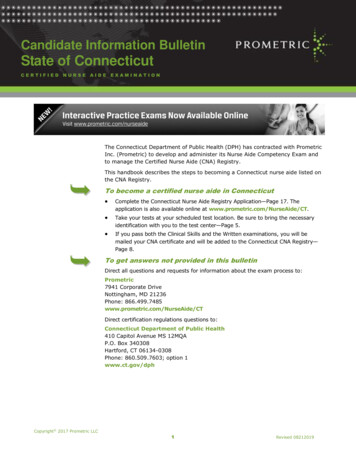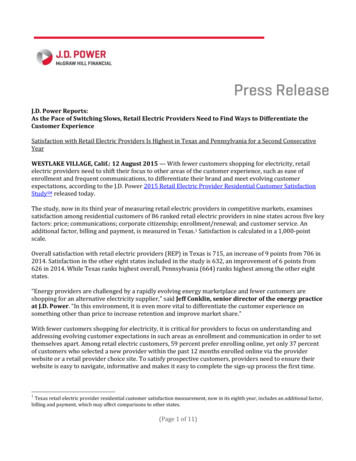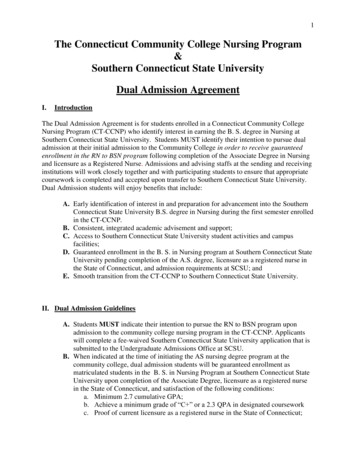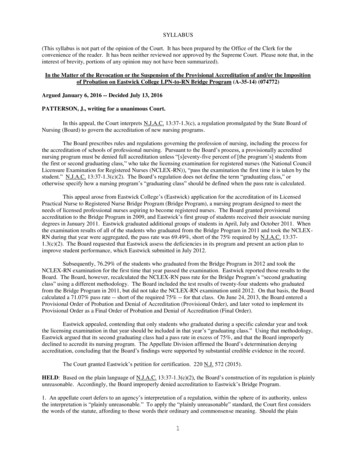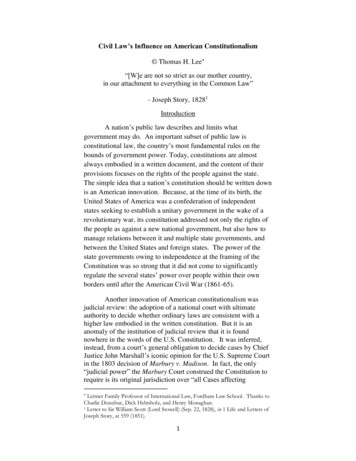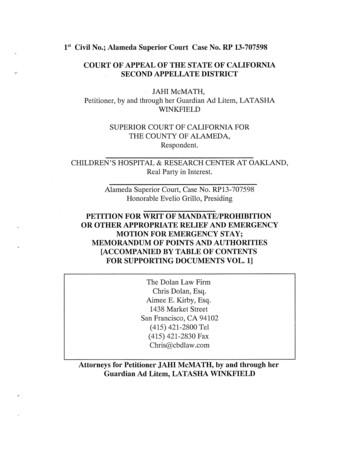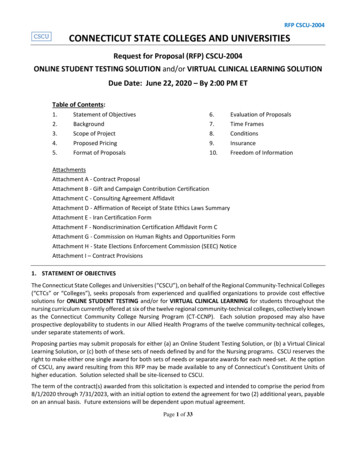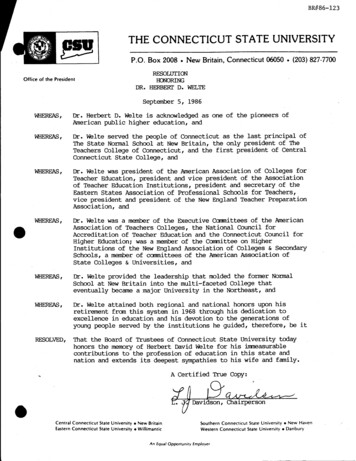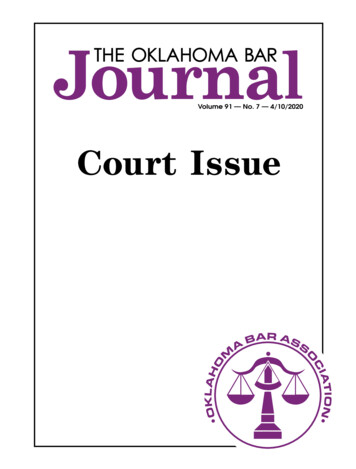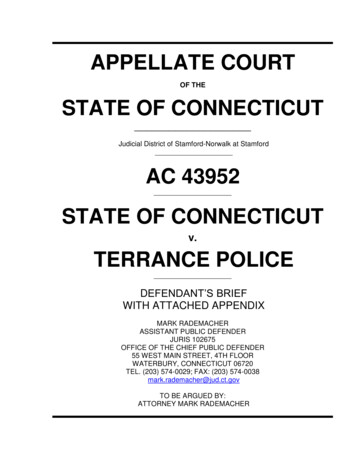
Transcription
APPELLATE COURTOF THESTATE OF CONNECTICUTJudicial District of Stamford-Norwalk at StamfordAC 43952STATE OF CONNECTICUTv.TERRANCE POLICEDEFENDANT’S BRIEFWITH ATTACHED APPENDIXMARK RADEMACHERASSISTANT PUBLIC DEFENDERJURIS 102675OFFICE OF THE CHIEF PUBLIC DEFENDER55 WEST MAIN STREET, 4TH FLOORWATERBURY, CONNECTICUT 06720TEL. (203) 574-0029; FAX: (203) 574-0038mark.rademacher@jud.ct.govTO BE ARGUED BY:ATTORNEY MARK RADEMACHER
TABLE OF CONTENTSSTATEMENT OF THE ISSUE . ivTABLE OF AUTHORITIES .vNATURE OF THE PROCEEDINGS . 1FACTS OF THE CASE . 11. The Robbery and the Shooting . 22. The Suspect’s Path of Flight . 33. The Man on the Bus . 34. Officers Find Clothing, an iPhone Cover andA Gun along the Suspect’s Path of Flight . 45. The Defendant’s Cousin Identified Him asThe Suspect but Norwalk Police Failed toFollow Up on the Lead . 46. The Norwalk Police Closed the InvestigationAnd Drafted the John Doe DNA Warrant . 57. The John Doe Warrant Contains a MixtureOf Partial Profiles for Which No MatchProbability Is Given . 58. Some of the Defendant’s Alleles HaveDropped Out of the Crime Scene Samples . 99. Déjà vu; The Defendant BecomesA Suspect Again . 1210. The Norwalk Police Learn that the 2012DNA Test Results from the Sweatshirt andiPhone Cover May Not Have Been SufficientFor a Databased Match to the Defendant’sProfile Because They Were Low CopyNumber Unresolved Mixtures . 1311. The Police Obtain a Search WarrantFor a DNA Sample from the Defendant . 13i
12. The Lab Did Additional Testing WhichProduced New Profiles from the CrimeScene Evidence that Implicated theDefendant as the Perpetrator andLed to His Arrest . 1413. The Hearing on the Motion to Dismiss. 14ARGUMENT . 15Issue: An Arrest Warrant Identifying the SuspectWith a Mixed Partial DNA Profile fromCrime Scene Evidence for Which No MatchProbability Was Given Violated theConstitutional Particularity and StatutoryReasonable Certainty Requirements andSo, Did Not Commence the ProsecutionWithin the Statute of Limitation . 15Summary. 151. The Relevant Facts . 161.1. The DNA Evidence in the Warrant Affidavit. 161.2. The Trial Court’s Decision . 172. The Issue Was Preserved and Is ReviewableOn Appeal . 213. The Standard of Review . 234. The Defendant Was Not Identified asThe Perpetrator Through a CODISSearch of the Profiles in the John DoeWarrant and Therefore, the IssuanceOf the Warrant Did Not Toll the RunningOf the Statute of Limitations . 245. The Issuance of an Arrest Warrant Naming“John Doe” and Identifying Him with a Suspect’sDNA Profile for Which No Match Probability IsGiven Did Not Constitute the Initiation of aProsecution that Tolls the Statute of Limitation . 24ii
5.1. The DNA profile in the John Doe warrantwas not the best description available anddid not identify anyone with particularityor reasonable certainty . 245.1.1. The arrest warrant did not satisfy theparticularity requirement of the FourthAmendment and the statutory reasonablecertainty requirement . 255.1.2. Partial profiles generate partial matchesthat exclude fewer people because thereare fewer data points for comparison . 305.1.3. Unresolved mixtures generate profilesthat exclude fewer people . 315.2. A John Doe Warrant Tolls the Statute ofLimitations Only When the Police Act withDue Diligence in Investigating the Case . 34CONCLUSION . 35iii
ISSUE PRESENTEDIssue: Did an Arrest Warrant Identifying the SuspectWith a Mixed Partial DNA Profile from CrimeScene Evidence for Which No Match ProbabilityWas Given, Violate the Constitutional ParticularityAnd Statutory Reasonable Certainty RequirementsAnd So, Did Not Commence the ProsecutionWithin the Statute of Limitation? . Pages 15-35iv
TABLE OF AUTHORITIESConstitutional ProvisionsConn. Const., art. 1, § 7 . 16, 22, 24, 25Conn. Const., art. 1, § 9 . 25U.S. Const., amend. 4 . 16, 22, 24, 25, 35United States Supreme Court CasesAndresen v. Maryland,427 U.S. 463 (1976) . 25District Attorney’s Office for Third Judicial Dist. v. Osborne,557 U.S. 52 (2009) . 24, 25Marron v. United States,275 U.S. 192 (1927) . 25Maryland v. Garrison,480 U.S. 79 (1987) . 25United States v. Marion,404 U.S. 307 (1971) . 35West v. Cabell,153 U.S. 78 (1984) . 26Connecticut CasesIn re Yasiel R.,317 Conn. 773, 120 A.3d 1188 (2015) . 22State v. Alston,272 Conn. 432, 862 A.2d 817 (2005) . 22State v. Golding,213 Conn. 233, 567 A.2d 823 (1989) . 22State v. Haight,279 Conn. 546, 903 A.2d 217 (2006) . 23v
State v. Kitchens,243 Conn. 690, 707 A.2d 1255 (1998) . 23State v. McDaniel,104 Conn.App. 627, 934 A.2d 847 (2007) . 22State v. Pappas,256 Conn. 854, 776 A.2d 1091 (2001) . 5State v. Saturno,322 Conn. 80, 139 A.3d 629 (2016) . 22State v. Swebilius,325 Conn. 793, 159 A.3d 1099 (2017) . 23State v. Ward,306 Conn. 698, 52 A.3d 591 (2012) . 23State v. White,195 Conn.App. 618, 226 A.3d 1066 (2020) . 22State v. Woodtke,130 Conn.App. 734, 25 A.3d 699 (2011) . 35Other State CasesCommonwealth v. Dixon,458 Mass. 446, 938 N.E.2d 878 (2010). 27, 28Commonwealth v. Mattei,455 Mass. 840, 920 N.E.2d 845 (2010) . 30Commonwealth v. O'Laughlin,446 Mass. 188, 843 N.E.2d 617 (2006) . 7People v. Martinez,52 A.D.3d 68, 855 N.Y.S.2d 522 (2008) . 27People v. Montoya,255 Cal.App.2d 137, 63 Cal.Rptr. 73 (1967) . 26People v. Robinson,47 Cal.4th 1104, 104 Cal.Rptr.3d 72, 224 P.3d 55 (2010) . 27Roberts v. United States,916 A.2d 922 (D.C.App. 2007) . 7, 32, 33vi
State v. Bander,150 Wash.App. 690, 208 P.3d 1242 (2009) . 8, 30, 33State v. Belt,285 Kan. 949, 179 P.3d 443 (2008) . 21, 27, 28, 29State v. Burdick,395 S.W.3d 120 (Tenn. 2012) . 27State v. Carlson,845 N.W.2d 827 (Minn.App. 2014) . 26, 27State v. Dabney,264 Wis.2d 843, 663 N.W.2d 366 (2003) . 26, 27, 28State v. Danley,138 Ohio Misc.2d 1, 853 N.E.2d 1224 (2006) . 27, 35State v. Gulley,2015 WL 5155579 (Ohio App. 2015) . 26State v. Link,25 S.W.3d 136 (Mo.2000) . 32State v. Neese,239 Ariz. 84, 366 P.3d 561 (2016) . 26, 27State v. Pettry,2017 WL 1506092 (Ohio App. 2017) . 34, 35State v. Twiggs,233 N.J. 513, 187 A.3d 123 (2018) . 24State v. Whittey,149 N.H. 463, 821 A.2d 1086 (2003) . 7State v. Younge,2013 UT 71, 321 P.3d 1127 (2013) . 27United States v. Jenkins,887 A.2d 1013 (D.C.App. 2005) . 32Young v. State,388 Md. 99, 879 A.2d 44 (2005) . 30, 32vii
Connecticut General StatutesConn. Gen. Stat. § 53a-59 (a) (1) . 1Conn. Gen. Stat. § 53a-134 (a) (1) . 1Conn. Gen. Stat. § 54-2a (a) . 16, 22, 24, 25, 35Conn. Gen. Stat. § 54-94a . 1Conn. Gen. Stat. § 54-193 . 24, 35Conn. Gen. Stat. § 54-193b . 24Connecticut Practice Book ProvisionsConn. Prac. Bk. § 36-1 . 16, 22, 25, 35Conn. Prac. Bk. § 36-3 . 16, 22, 24, 25, 35Conn. Prac. Bk. § 60-5 . 22Conn. Prac. Bk. § 61-6 (a) (2) (A) . 1MiscellaneousDavid Faigman, et al., 4 Modern Scientific Evidence:The Law and Science of Expert Testimony (2020) . 29Justice Ming W. Chin, et al.,Forensic DNA Evidence: Science and the Law (2020) . 30, 32, 33Jones on Evidence (7th ed.) . 32Meredith A. Bieber, Comment, Meeting the Statute orBeating It: Using “John Doe” Indictments Based onDNA to Meet the Statute of Limitations,150 U. Pa. L.Rev. 1079 (2002) . 28Murphy, The Art in the Science of DNA: A Layperson'sGuide to the Subjectivity Inherent in Forensic DNA Typing,58 Emory L.J. 489 (2008) . 25viii
National DNA Index System (NDIS) Operational ProceduresManual (2012). Available alFinal-1-31-2013-1.pdf . 29National DNA Index System (NDIS) OperationalProcedures Manual (2019).Available at al-procedures-manual.pdf/view . 29National Research Council, The Evaluation ofForensic DNA Evidence (NRC II) (1996)available at https://www.ncbi.nlm.nih.gov/books/ NBK232607/ . 7Rudin, N., Inman, K.,Introduction to Forensic DNA Analysis, 2d Ed. (2002) . 6Scientific Working Group on DNA AnalysisMethods Ad Hoc Committee on PartialMatches (October 2009) (SWGDAM).Available at ensic-science-communications/fsc/oct2009/ standard guidlines/swgdam.html . 29U.S. Department of Justice, DNA for the DefenseBar (2012) available at https://www.ncjrs.gov/pdffiles1/nij/237975.pdf . 9, 30, 32Wayne R. LaFave, Search and Seizure:A Treatise on the Fourth Amendment, (5th ed.) . . 26ix
NATURE OF THE PROCEEDINGAt 1:40 pm on the tenth of October 2012, Francoise Williams was shot during arobbery while in her car in the parking lot of Stop and Shop at 385 Connecticut Avenue inNorwalk. App. A4-A6. On May 1, 2017, four months before the five-year statute of limitationsexpired, the Honorable Gary J. White, Judge, signed a “John Doe” arrest warrant containingDNA profiles from the suspect obtained from crime scene evidence. App. A1-A10. On April6, 2018, almost seven months after the statute of limitations had run, the Honorable RobertF. Comerford Jr, Judge, signed a search warrant to obtain a sample of the defendant’s DNA.App. A10-A21. A month later, on May 4, 2018, the police arrested the defendant on the JohnDoe warrant after his DNA profile matched the one from the crime scene evidence. App. A66.The State’s Attorney for the Judicial District of Stamford-Norwalk charged him withRobbery in the first degree, Conn. Gen. Stat. § 53a-134 (a) (1) (robbery while armed with adeadly weapon), and Assault in the first degree, Conn. Gen. Stat. § 53a-59 (a) (1) (assaultcausing serious physical injury by means of a deadly weapon). App. A24, A66. On February8, 2019, he filed a motion to dismiss claiming that the statute of limitations had run. App.A24-A43. In February and March of 2019, the Honorable John Blawie, Judge, held ahearing and on July 19, 2019, filed his written decision denying the motion. App. A24, A44A64. On November 4, 2019, the Honorable Gary J. White, Judge, accepted the defendant’swritten plea of nolo contendere reserving his right to appeal the denial of his motion todismiss pursuant to Conn. Gen. Stat. § 54-94a and Conn. Prac. Bk. § 61-6 (a) (2) (A), andthat day sentenced him to concurrent sentences of ten years on each count, five years ofwhich were mandatory. App. A12, A65. On February 21, 2020, he appealed. App. A68.FACTS OF THE CASEThis case is a cautionary tale about over reliance by police on complex DNAevidence that they did not understand and their misplaced belief that it can always solve acrime. Their misplaced reliance and belief mislead a judge to sign a John Doe arrestwarrant in which the DNA profiles did not establish probable cause to believe that a1
particular person had committed the crime. As a result, the police did not arrest thedefendant within the statute of limitations, and the charges must be dismissed.The facts found by Judge Blawie were taken from the affidavits for the John Doearrest warrant (JDW) and the search warrant for the defendant’s DNA (SW) and from thetestimony of the officer who was in charge of the investigation and of the person from thestate forensic lab who was in charge of the state’s Combined DNA Index System or CODIS.1. The Robbery and ShootingThe victim parked her white Mercedes Benz at the far end of the Stop and Shopparking lot while she walked her dog. She returned to her car and was responding to anemail when a man opened the driver’s door and pushed her inside. She described herassailant as a black male, medium build, about five feet eleven inches to six feet tall,between eighteen and thirty years-old, with a light beard. The man wore jeans and a darkhooded sweatshirt with the hood over his head and part of his face, and with the sleevespulled over his hands. The man pulled out a small silver gun and asked for her jewelry andiPhone. During the ensuing struggle, he fired the gun into her abdomen. After she was shot,she took off her engagement ring, wedding band and two other rings and gave them to himalong with her IPhone. The iPhone had a pink flexible Kate Spade case cover. Her assailantran out of the parking lot, across Connecticut Avenue and into the Best Buy strip mall. Laterat the hospital, an officer received a .22 caliber bullet that a doctor had removed from thevictim. App. A5-A6 (JDW, ¶ 5, 6, 8), A-11-A14 (SW, ¶3, 4, 8, 9); Memo. 4; App. A30.As Diane Garrison pulled into the parking lot, to eat a sandwich, she saw a manfifteen feet behind the Mercedes, bent over with his back towards her. He appeared to betaking something out of his sock or shoe and looked directly at her as she drove by.Garrison described him as a lite skinned black male, about six feet tall, in his mid-twenties,slender build, with little to no facial hair, wearing a dark hooded zip-up sweatshirt, jeans,and black canvas slip-on shoes with white soles. She parked her car and as she took a biteof her sandwich, she heard the victim scream. She looked over at the Mercedes and saw2
the man’s feet dangling out of the open driver’s door as he struggled with the victim.Garrison told a couple standing nearby to call 911, and she began hitting her car’s horn.She heard a gunshot and saw the man run out of the parking lot and across ConnecticutAvenue towards the strip mall. In the mall on the left is the Rio Restaurant, which is at theentrance to the strip mall, which has a T.J. Max and Best Buy. A side of the restaurant facesthe street and the front faces into the parking lot. He ran along the side of the restauranttowards the back of the strip mall. She then saw the victim get out of her car and yell, “I’vebeen shot!” App. A5-A6 (JDW, ¶ 6); A12-A13 (SW, ¶ 6); Memo. 5; A48.2. The Suspect’s Path of FlightA waitress at the Rio Restaurant saw a man run along the side of the restaurant tothe back of the building. He had his right hand tucked in his pocket, was looking aroundand appeared suspicious. She described him as a black male, about five feet ten inchestall, weighing about one hundred and seventy pounds, wearing a blue sweatshirt or jacketand jeans. A surveillance video from the restaurant showed a black man with a bald headwearing jeans, dark colored sneakers and a zip-up dark colored sweatshirt over a darkcolored V-neck sweater and white shirt. The video showed him running along the side ofthe restaurant then walking behind the mall, looking back and then he began runningbehind T.J. Maxx and Best Buy and out of sight. Later that day, images from thesurveillance video were given to the news media in an effort to identify the suspect. App.A6-A7 (JDW ¶ 7, 11, 12, 13); App. A13-A14 (SW ¶7, 8, 9); Memo. 5; A48; 3/21 Tr. 25-26.Dominique Sinclair lived in an apartment in a housing project at 196 Suncreast Roadlocated behind the far end of the mall. Shortly after the shooting, a young thin black manappeared at her front door. She let him in but then noticed blood on his t-shirt and told himto leave. App. A15, A16-A17 (SW, ¶ 16, 19).3. The Man on the BusAn hour or so after the shooting, a person, who asked to remain anonymous, toldpolice that he boarded a city bus at 493 Connecticut Avenue, a short distance from Stop3
and Shop. The person sat opposite, a light skinned black male in his mid-20s to 30swearing a white t-shirt, jeans and black canvas sneaker, who had a tear drop-like tattoounder his left eye. The man was talking on a cell phone and said, “Meet me at the trainstation,” and “Well GPS it then.” As the bus went by the crime scene where the police werestill investigating, the man bent down as if to tie his shoe so that he would not be seen bythe police. He did so again when the bus passed another officer. Police surmised that hewas the suspect in the shooting and was on his way to the Norwalk train station. Officersretrieved surveillance video from the station and spotted the suspect. The video was shownto the public through the news media. App. A12-A13, A15 (SW ¶ 6, 15) 3/21 Tr. 32-33.4. Officers Find Clothing, an iPhone Cover and a Gun along the Suspect’s Path ofFlight.On October 13, 2012, three days after the robbery, officers retraced the suspect’spath of flight as shown in the videos. 3/21 Tr. 25-26. Outside the stockade fence that linedthe rear of the strip mall, they found a dark blue, zip-up hooded sweatshirt, a sweater and a.22 caliber silver revolver. The bullet retrieved from the victim was matched to the gun.Officers sent the sweatshirt, and swabbings from the gun and the victim’s car to the StateForensic Lab for DNA testing. At the lab, an analyst found in the pocket of the sweatshirt, apink iPhone cover that was taken from the victim and swabbed it for DNA. The lab testedsamples form the victim’s car, the sweatshirt, the iPhone cover and the gun but only theprofiles from the sweatshirt and the iPhone cover produced profiles appropriate for entry inthe CODIS databases. The database search that day did not turn up any matches. App. A6A8 (JDW, ¶8-10, 14, 16, 17), A13-A14 (SW ¶9, 10, 11); Memo. 5; App. A48; 3/21 Tr. 26.5. The Defendant’s Cousin Identified Him as the Suspect but Norwalk Police Failedto Follow Up on the Lead.On December 29, 2012, about two and a half months after the robbery and a weekafter the DNA data base search did not turn up a match, the defendant’s cousin calledNorwalk police and said that the defendant looked identical to the suspect in the video hehad seen on TV and told members of his family that he had shot the victim. The lead4
Detective David Orr believed that he had “a verifiable DNA profile” from the suspect andhad asked the state lab to run a CODIS search. Orr had the cousin’s phone number, but didnot call him or the defendant and his family. Orr learned the defendant had been convictedof a felony but did not get the defendant’s arrest photo to see if he looked like the suspectin the surveillance videos. Orr learned from the state lab that all offender samples through2012 had been entered into the databases. Therefore, he assumed that the defendant’sDNA profile was in the databases that had been searched a week earlier without turning upany matches. “It effectively vetted Mr. Police, in our opinion, as a suspect at that time,” Orrsaid. And so, Orr eliminated him as a suspect without any further investigation. Orr waspromoted in 2014 and thereafter, was no longer responsible for the case. 3/21 Tr. 39-40.App. A14 (SW ¶ 12); Def.’s exh. C (December 21, 2012 DNA Data Base Search Report,page 4); App. A77; Memo. 6; App. A49; 3/21 Tr. 24-40.6. The Norwalk Police Closed the Investigation and Drafted the John Doe Warrant.In July of 2013, nine months after the robbery, the Norwalk police felt it had exhaustedall investigative leads and closed its investigation with the only continuing activity being theongoing weekly searches of the DNA databases for a match to the profiles from thesweatshirt and iPhone cover. On April 6, 2017, over four years and three months after theoffense, Detective Tomasz Podgorski, who had taken over the investigation, drafted a JohnDoe arrest warrant into which he copied the DNA profile of the suspect from the sweatshirtand iPhone cover. In the warrant, he stated that he “believe[d] there is probable cause forthe statute of limitations to be halted until the pending arrest of John Doe, an unknownmale identifiable by the above listed DNA profile” for robbery and assault. On May 1, 2017,Judge White signed the warrant. App. A7-A9 (SW ¶ 13, 23); 3/21 Tr. 45-46.7. The John Doe Warrant Contained Profiles from a Mixture of Partial Profiles forWhich No Match Probability Is Given.The results of DNA testing1 are produced as peaks on a graph called an1For STR testing generally, see State v .Pappas, 256 Conn. 854, 866-875 (2001)5
electropherogram. Each peak is labeled with the number of STR repeats for the allele,2 thechromosome on which it is located, the location on that chromosome and the height of thepeak, which corresponds to the amount of DNA at that locus. For a single source sample, itwill show two peaks for each locus if the person's two alleles from each parent are different(heterozygous), or one larger peak, roughly twice the height of a heterozygous peak, if theperson's two alleles are the same (homozygous). The two alleles at a locus are the person’sgenotype. If a person's two alleles at a particular locus are the same length, for example 14repeats long, the person's genotype is 14, 14. If the person's two alleles at a particular locushave different lengths, for example, 14 and 19 repeats long, the person’s genotype is 14, 19.The scientific community and Congress have chosen 13 core loci for analysis3 to create aprofile for a suspect or any other relevant person, such as a victim who likely contributed tothe sample. Roberts v. United States, 916 A.2d 922, 926 (D.C.App. 2007). A DNA profileconsists of a string of two numbers grouped with their corresponding locus. A profile iswidely said to identify an individual when all twenty-six alleles at the thirteen core loci match.Matches can occur at less than the thirteen loci but the statistical weight is less. And withthe loss of several loci, the statistical weight rapidly decreases. See discussion page 31-34.A match requires a second piece of information—the statistical frequency of theprofile. A match between two profiles means nothing without statistical evidence as to thelikelihood that other individuals in a given population would also match.4 The significance of(explaining the steps in processing DNA samples in the context of mitochondrial DNA).2 Allele: “One of two or more alternative forms of a gene or genetic marker” at aspecific locus. Rudin, N., Inman, K., Introduction to Forensic DNA Analysis, 2d Ed. (2002) at203. Every person has one allele form each parent, which may be the same or different. Id.3 The thirteen core loci are: CSF1PO, FGA, THO1, TPOX, VWA, D3S1358, D5S818,D7S820, D8S1179, D13S317, D16S539, D18S51, D21S11. In 2012, the samples weretested at fifteen loci plus the sex locus. In 2017, the FBI increased the thirteen core loci totwenty core loci for CODIS searches. In 2018, the samples were retested at twenty-six lociplus the sex locus. Because most older offender profiles were tested only at the thirteen loci,these loci are used for matching, even if the known samples was tested at more loci.4 See National Research Council, The Evaluation of Forensic DNA Evidence (NRCII) (1996) Chapter 6 DNA Evidence in the Legal System
APPELLATE COURT OF THE STATE OF CONNECTICUT _ Judicia
